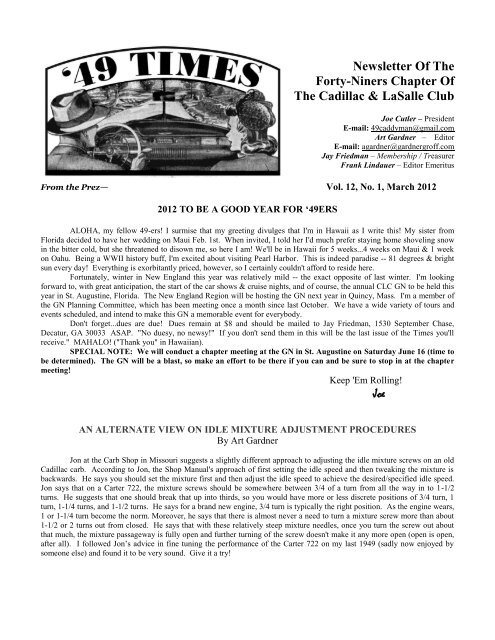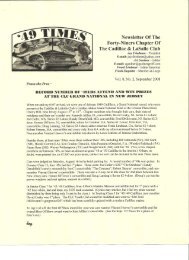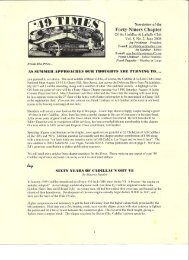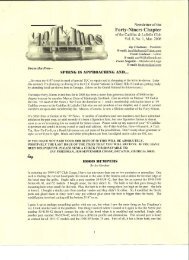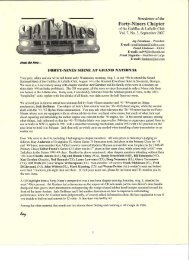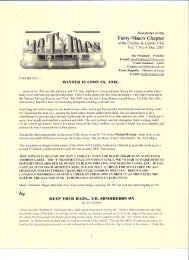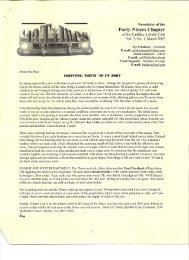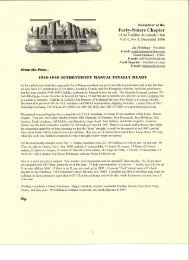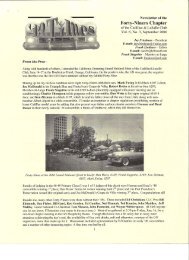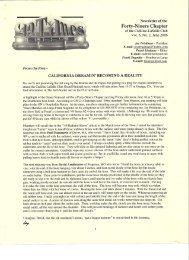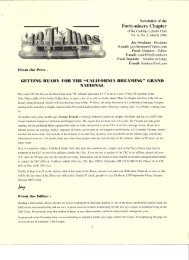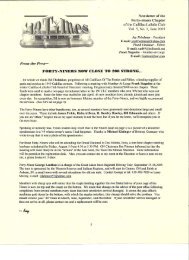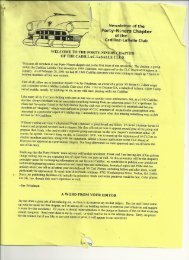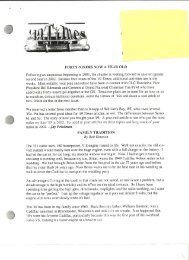March 2012
Create successful ePaper yourself
Turn your PDF publications into a flip-book with our unique Google optimized e-Paper software.
Newsletter Of The<br />
Forty-Niners Chapter Of<br />
The Cadillac & LaSalle Club<br />
Joe Cutler – President<br />
E-mail: 49caddyman@gmail.com<br />
Art Gardner – Editor<br />
E-mail: agardner@gardnergroff.com<br />
Jay Friedman – Membership / Treasurer<br />
Frank Lindauer – Editor Emeritus<br />
From the Prez— Vol. 12, No. 1, <strong>March</strong> <strong>2012</strong><br />
<strong>2012</strong> TO BE A GOOD YEAR FOR ‘49ERS<br />
ALOHA, my fellow 49-ers! I surmise that my greeting divulges that I'm in Hawaii as I write this! My sister from<br />
Florida decided to have her wedding on Maui Feb. 1st. When invited, I told her I'd much prefer staying home shoveling snow<br />
in the bitter cold, but she threatened to disown me, so here I am! We'll be in Hawaii for 5 weeks...4 weeks on Maui & 1 week<br />
on Oahu. Being a WWII history buff, I'm excited about visiting Pearl Harbor. This is indeed paradise -- 81 degrees & bright<br />
sun every day! Everything is exorbitantly priced, however, so I certainly couldn't afford to reside here.<br />
Fortunately, winter in New England this year was relatively mild -- the exact opposite of last winter. I'm looking<br />
forward to, with great anticipation, the start of the car shows & cruise nights, and of course, the annual CLC GN to be held this<br />
year in St. Augustine, Florida. The New England Region will be hosting the GN next year in Quincy, Mass. I'm a member of<br />
the GN Planning Committee, which has been meeting once a month since last October. We have a wide variety of tours and<br />
events scheduled, and intend to make this GN a memorable event for everybody.<br />
Don't forget...dues are due! Dues remain at $8 and should be mailed to Jay Friedman, 1530 September Chase,<br />
Decatur, GA 30033 ASAP. "No duesy, no newsy!" If you don't send them in this will be the last issue of the Times you'll<br />
receive." MAHALO! ("Thank you" in Hawaiian).<br />
SPECIAL NOTE: We will conduct a chapter meeting at the GN in St. Augustine on Saturday June 16 (time to<br />
be determined). The GN will be a blast, so make an effort to be there if you can and be sure to stop in at the chapter<br />
meeting!<br />
Keep 'Em Rolling!<br />
Joe<br />
AN ALTERNATE VIEW ON IDLE MIXTURE ADJUSTMENT PROCEDURES<br />
By Art Gardner<br />
Jon at the Carb Shop in Missouri suggests a slightly different approach to adjusting the idle mixture screws on an old<br />
Cadillac carb. According to Jon, the Shop Manual's approach of first setting the idle speed and then tweaking the mixture is<br />
backwards. He says you should set the mixture first and then adjust the idle speed to achieve the desired/specified idle speed.<br />
Jon says that on a Carter 722, the mixture screws should be somewhere between 3/4 of a turn from all the way in to 1-1/2<br />
turns. He suggests that one should break that up into thirds, so you would have more or less discrete positions of 3/4 turn, 1<br />
turn, 1-1/4 turns, and 1-1/2 turns. He says for a brand new engine, 3/4 turn is typically the right position. As the engine wears,<br />
1 or 1-1/4 turn become the norm. Moreover, he says that there is almost never a need to turn a mixture screw more than about<br />
1-1/2 or 2 turns out from closed. He says that with these relatively steep mixture needles, once you turn the screw out about<br />
that much, the mixture passageway is fully open and further turning of the screw doesn't make it any more open (open is open,<br />
after all). I followed Jon‟s advice in fine tuning the performance of the Carter 722 on my last 1949 (sadly now enjoyed by<br />
someone else) and found it to be very sound. Give it a try!
FRED ENGLE’S CDV (CAMARILLO, CA), OWNED SINCE 1986<br />
IT WORKED FOR ME: STOPPING A STEERING BOX LEAK WITH SPECIAL LUBE<br />
By Jay Friedman<br />
Although my 49 steers precisely and easily, with no play or looseness at the steering wheel, my '49's steering gear box<br />
has always had a slow leak. I put a new gasket on the end cover a couple of years ago, but it did not improve things.<br />
Annoyingly, every month or so I‟ve had to top it up.<br />
After reading a CLC Forum thread on this subject and mulling over the suggested alternatives (all of which involve<br />
thicker oil or grease), I bought a ½ liter plastic bottle of Penrite Steering Box Lube for Vintage Cars (for anything without rack<br />
and pinion steering or power steering), an Australian-made flowable grease. It is sold in the U.S. by Restoration Supply<br />
Company in California and costs $17 per bottle, plus about $10 shipping. I ordered 2 bottles. When they arrived, I raised the<br />
front wheels off the ground, took off the left front wheel to provide better access to the steering box, and drained the oil from<br />
the steering box by removing the lower inboard bolt on the end cover. After replacing the bolt, I then removed the filler plug<br />
and squirted lube into the box by squeezing the bottle. To get it to settle in the box I had to turn the steering wheel from side to<br />
side a couple of times between squirts. One bottle was not enough to fill the box completely, so I had to use part of the 2 nd<br />
bottle. It took several days before the lube totally settled, so I checked the box after every drive and topped it up. The box no<br />
longer leaks.<br />
A QUESTION FROM AUTHENTICITY MANUAL COMMITTEE MEMBER<br />
(AND FORMER CLC PREZ) BILL EDMUNDS<br />
We have found paint chips for 1949 which include paint mixing formulas. Does anyone have<br />
similar literature for 1948 which includes paint mixing formulas that can be put in the next printing of the<br />
1948-49 Authenticity Manual?
DON CLEVELAND’s 1949 CADILLAC 60S<br />
Above is a beautiful example of an often-overlooked model – the fabulous 1949 60 Special. Thanks to Don<br />
Cleveland, of Perrysburg, OH, for submitting this picture of his wonderful car. Last summer, Don drove this stunner to<br />
Columbus for the 2011 Grand National: “I was so busy talking to folks who looked at my 1949 green Cadillac Fleetwood that I<br />
didn‟t find good „sun‟ time to get more pictures of my car.”<br />
TECH TIP: HORN WIRING<br />
By Ralph DeFilippo
NEW MEMBER JOHN WALKER’S 6207 CLUB COUPE<br />
(SEATTLE, WA)<br />
LISTING OF PARTS AVAILABLE FROM NAPA THAT MAY FIT A ’49 CADILLAC<br />
Part Description Manufacturer NAPA Part # Price Core<br />
Contact Set (Points) Echlin ECH CS777A $ 17.29<br />
Distributor Condenser Echlin ECH RR174 $ 8.49<br />
Distributor Cap Echlin ECH RR1580 $ 15.49<br />
Distributor Rotor Echlin ECH RR159 $ 14.29<br />
Spark Plug Wire Set - Premium BEL BEL 700170 $ 38.99<br />
Stoplight Switch Echlin ECH SL128 $ 24.49<br />
Thermostat Housing Gasket THM STM1 $ 1.09<br />
Thermostat - Premium (160?) THM THM 532060 $ 9.99<br />
Thermostat - Premium (180?= OEM) THM THM 532080 $ 9.99<br />
Thermostat - Premium (195?) THM THM 532090 $ 9.99<br />
Radiator Cap (13 lb.) Balkamp BK 7031445 $ 6.09<br />
Belt - Fan & Generator PBH NBH 257570 $ 18.29<br />
Generator Bushing – Front Echlin ECH AD1238 $ 4.49<br />
Generator Brush Echlin ECH SD725 $ 4.29<br />
Starter Brush Echlin ECH R503 $ 3.29<br />
Starter Repair Kit Echlin ECH SRK104 $ 27.49<br />
Starter Solenoid Repair Kit Echlin ECH STK2 $ 14.69
Inner Wheel Bearing - Front Wheel BRG B62 $129.00<br />
Outer Wheel Bearing - Front Wheel BRG B73 $ 95.49<br />
Wheel Seal - Front Wheel NOS 19940 $ 13.49<br />
Wheel Cylinder Kit - Front UP 36 $ 3.99<br />
Wheel Cylinder Kit - Rear UP 20 $ 3.99<br />
Brake Shoes - Front, Tru-Stop Tru-Stop TS TS127 $ 24.99 $ 6.50<br />
Brake Shoes - Rear, Tru-Stop Tru-Stop TS TS<br />
Wiper Blade – Classic WIP 601233 $ 13.29<br />
TECH TIP: WHAT TO DO IF YOUR MOTOR SUFFERS FROM VAPOR LOCK<br />
By Jay Friedman<br />
Lately, I've been hearing more stories about ‟49 Cads experiencing vapor lock. This ailment is due to engine heat<br />
causing gasoline to boil away or vaporize at certain spots in the fuel line. This makes for air in the fuel line, starving your<br />
engine of fuel, which will then stall or refuse to start. As ‟49 Cadillacs were not known for having this problem in the past, it<br />
makes me wonder if it is not some new problem with the formulation of gasoline. The following may help and if any members<br />
have additional suggestions, please send them to the Times:<br />
1. Check to see if air is freely flowing through the radiator and that the motor is running at a normal temperature;<br />
2. Check your steel fuel line make sure it is not passing to close to the driver‟s side exhaust manifold and check the<br />
flexible fuel line from the end of the steel line into the fuel pump to make sure it is not touching or passing very close to the oil<br />
filler housing or another hot part of the motor;<br />
One possible solution is to wrap an insulating material around the rubber fuel line between the end of the steel line and<br />
the fuel pump. You can also do the same for the steel line between the pump and the carburetor. A good insulator is a length<br />
of rubber fuel line or, alternatively, insulated hose used for radiator return lines. It should be of the right diameter; that is, of<br />
course, bigger than the line to be wrapped. Cut it longitudinally (along its length) and place it around the length of the fuel line<br />
to be insulated. It's expensive (at $4 / foot here in GA), but if it solves the problem is money well spent. Another insulation<br />
material is aluminum foil. I'm not sure about other alternatives to cover the fuel lines, but you can try McVey's for some<br />
insulating material, as they do sell stuff of this type for exhaust pipes, or go to a hardware store and see what they suggest.<br />
Another solution is to install an electric fuel pump. If you do so, I would not do away with the mechanical pump, but<br />
merely have the electric pump as an auxiliary. I have such a set up on 2 of my cars (but not my '49 Cad which does not vapor<br />
lock yet). Install it so that the electric pump on a separate small fuel circuit with 2 "T" connections near the fuel tank and not<br />
merely in line with the mechanical pump. A more ambitious electric fuel pump installation involves installing a "T"<br />
connection just outside the fuel tank, with one branch of the "T" connection serving the existing steel fuel line and the<br />
mechanical pump. From the 2nd branch of this "T" connection near the fuel tank, install a short line to the electric pump.<br />
From the outlet of the electric pump install a second long steel fuel line, parallel to the long steel existing line, all the way to a<br />
rubber line going into a second "T" connection near the carburetor, thereby bypassing the mechanical pump altogether. This<br />
second set-up will look funny but will probably work well. The mechanical pump puts out 4 to 5¼ lbs, so the electric pump<br />
should not put out more than this.<br />
If you suspect your engine temperature is too hot, a good way to accurately check it is to temporarily hook up a<br />
mechanical temp gauge to the same point on the rear of the passenger's side cylinder head as the stock electrical sending unit.<br />
You can buy one and any necessary screw-in adapter inexpensively at an auto parts store. You install it by temporarily<br />
removing the passenger's side ventilating tube, run the cable through the hole and gently close the vent valve over the cable to<br />
prevent most hot air entering the engine compartment. I've done this with my own car and have been surprised at the<br />
difference in readings between the stock electrical and auxiliary mechanical temperature gauge readings.<br />
On the other hand, the motor‟s symptoms may be due to something else altogether, a constricted fuel line. See John<br />
Washburn‟s article in the May 2011 Self Starter.
EARLY 1949 CADILLAC ENGINE PRODUCTION LINE<br />
(NOTE BRIGHT GENERATOR FAN AND TWO-BOLT VALVE COVERS)<br />
TECH TIP FOR BLEEDING BRAKES AFTER REPLACING BRAKE LINES<br />
By Art Gardner<br />
If you replace brake lines and/or replace or re-do wheel cylinders, it can be a chore to get all of the air back out of the<br />
lines and cylinders. Here is a trick I came up with recently (this probably been used by lots of mechanics over the years, but it<br />
only occurred to me in the last month or so).<br />
The idea is to fill the lines and the cylinders as full as possible with fluid before installing them. Recently, we<br />
replaced the rear lines, rear hose, F-to-R line, and rebuilt the rear wheel cylinders on my „50. To avoid endless pumping and<br />
bleeding of the brakes, I filled the cylinders as full as I could with fresh fluid, then attached the new (relatively short) steel lines<br />
and snugged them up. Then I filled the line and the cylinder the rest of the way by pouring brake fluid down the line, using a<br />
skinny awl to lead the fluid into the line like a reverse funnel. (See drawing on next page.) After filling the line and cylinders<br />
completely, we put a tight rubber cap on the end of the line and installed the cylinder/line. For the flexible rubber brake hose<br />
and the F-to-R steel line, we did basically the same thing.<br />
We had removed the wheel cylinders to rebuild them and were installing new lines at the same time. So pouring the<br />
fluid into the lines up was no trouble. If you were doing it with the wheel cylinders still on the car, you could put a rubber hose<br />
on the end of the line and bend up the rubber hose to give you a vertical run to pour into and to provide the elevation change<br />
needed to force the air to rise up and out of the line. If you do it with the wheel cylinder still on the car, you might need to<br />
open the bleeder valve to let some of the air out that way. Since I had the lines oriented vertically with the wheel cylinders off<br />
the car, I didn't need to open the bleeder and the air escaped up the line.<br />
As a result, there was very little spillage and it didn't take very long to fill the system or bleed the brakes. The net<br />
effect is that when we bled the brakes, there was very, very little air in the system that needed to be purged. We had a firm<br />
pedal almost from the start and the entire bleeding process only took about 10 minutes.
1948 “BONE BOX” OWNED BY MARK RODGERS (OHIO)


